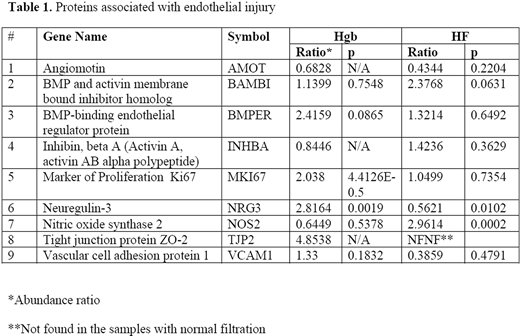BACKGROUND: Sickle cell anemia (SCA) patients are predisposed to the development of chronic kidney disease (CKD). Vascular dysfunction plays an important role in the etiology of CKD and is a major complication in SCA. Biomarkers of endothelial dysfunction VCAM and Activin A were recently described for diagnostics of CKD in Diabetic Kidney Disease and Systemic Lupus Erythematosus. Previously, we identified several urinary biomarkers of CKD in SCA patients using mass-spectrometry analysis. These biomarkers reflect the pathophysiology of SCA, including markers of iron homeostasis (ceruloplasmin (CP), transferrin (TrF), hemoglobin (Hgb), ferritin (FrT)); inflammation (orosomucoid (ORM)); and glomerular hyperfiltration (HGFL). However, the urinary biomarkers of endothelial injury in SCA patients are unknown.
HYPOTHESIS: We hypothesized that urinary biomarkers of endothelial injury can be identified by mass-spectrometry and that they correlate with hemoglobinuria and hyperfiltration.
METHODS: We tested mass-spectrometry data obtained from spot urine samples of 19 SCA patients without CKD in a steady state from the University of Illinois at Chicago. Samples were run in triplicates (total 57 spectra) and mass spectrometry analysis was carried out using Proteome Discoverer 2.2 (Thermo Fisher Scientific) and Ingenuity Pathway Analysis (IPA, Qiagen) software. Protein abundances were calculated using Proteome Discoverer 2.2 and correlated with hyperfiltration and hemoglobinuria.
RESULTS: We re-analyzed previously obtained mass-spectra using the recently released Proteome Discoverer 2.2 program and identified 819 proteins that were further analyzed with IPA software. Proteins were sorted into the categories associated with renal necrosis (31 proteins), glomerular injury (16 proteins), and renal hypoplasia (9 proteins) using IPA. Because of a lack of vascular injury pathways in IPA, nine proteins associated with endothelial or vascular injury were manually picked including VCAM and Activin A (Table 1). Abundances were calculated for each of the nine selected proteins related to endothelial injury in 57 samples and normalized to the urinary creatinine. Results were stratified for hemoglobinuria and hyperfiltration. Four proteins showed 2-4 fold higher abundances in the samples with hemoglobinuria (BMPER, NRG3, MKI67, and TJP2), but the increase was statistically significant for NRG3 and MKI67 only. In the samples from patients with hyperfiltration, BAMBI and NOS2 abundances were increased over 2-fold but the abundance of NRG3 was decreased. Ingenuity network analysis showed changes in immunoglobulin production for MKI67 network; ERK1/2 signaling for NRG3 pathway; cell cycle and NF-kB signaling for BAMBI and cell cycle proteins and RNA polymerase II transcription for NOS2 network.
CONCLUSIONS: Markers of endothelial injury are found in the urinary proteome in correlation with hemoglobinuria and hyperfiltration. Further analysis to validate these biomarkers and correlate them with CKD progression is needed.
LIMITATION: Research participants were from a small cohort of patients from one center.
ACKNOWLEDGMENTS: This work was supported by NIH Research Grants (1P50HL118006, 1R01HL125005, 5G12MD007597 and 1SC1HL150685). The content is solely the responsibility of the authors and does not necessarily represent the official views of the National Institutes of Health.
Saraf:Novartis, Global Blood Therapeutics: Membership on an entity's Board of Directors or advisory committees; Global Blood Therapeutics: Membership on an entity's Board of Directors or advisory committees, Other: Advisory Boards, Speakers Bureau; Pfizer, Global Blood Therapeutics, Novartis: Research Funding. Gordeuk:Imara: Research Funding; Ironwood: Research Funding; Novartis: Consultancy; CSL Behring: Consultancy, Research Funding; Global Blood Therapeutics: Consultancy, Research Funding.
Author notes
Asterisk with author names denotes non-ASH members.


This feature is available to Subscribers Only
Sign In or Create an Account Close Modal